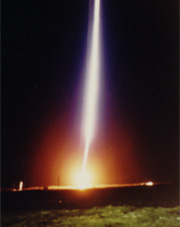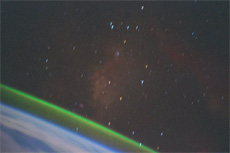|
|
| The ETON Rocket Campaign 25th Anniversary Workshop |
|
|
South Uist, The Hebrides, Scotland, March 23 and 24, 2007
Seven rockets were launched from South Uist, Scotland, March 23, 1982, to probe Earth's nightglow layer, 100 kilometres above
the Earth's surface.
| To celebrate the 25th Anniversary of ETON (Energy Transfer in Oxygen Nightglow), a special workshop on nightglow studies is being held near the ETON launch site in South Uist, in The Herbrides.
The workshop is supported by the Canadian Space Agency, successor to the Canadian National Research Council's Space Division, which contributed to the success of this important study of the near-Earth space environment.
The workshop will be held on the island of Benbecula just north of South Uist at The Isle of Benbecula House Hotel. For information, refer to the hotel website. This venue, formerly known as the Creagorry Hotel, was home to the original ETON rocketeers. |

One of the ETON rockets blasts upward to the nightglow region on March 23, 1982.
(Photo: York University) |
For more information on the workshop program, registration, travel and accommodation logistics, please contact:
Ian McDade
Chair, ETON 25th Workshop Program Committee
Department of Earth and Space Science and Engineering
York University
4700 Keele Street
Toronto, Ontario M3J 1P3
Canada
Tel.: 416-736 2100, extension 40124
Fax.: 416-736 5817
E-mail: mcdade@yorku.ca

One of the ETON rockets blasts upward to the nightglow region on March 23, 1982.
(Photo: York University)
About the Nightglow
Light is emitted from a thin glowing shell of Earth's atmosphere about 100 km above the surface and about 10 km thick. This is the nightglow. The pressure in this area is only about one millionth of the surface pressure, and the temperature is about -100ºC.
| Unlike the polar aurora, which appear sporadically near the poles and are powered by a stream of charged particles that flows out from the Sun, the nightglow exists all over the globe and is fairly constant in intensity, apart from daily variations induced by tides. Chemical reactions in the very cold rarefied air of this high altitude region of Earth's atmosphere and the near Earth space environment cause the nightglow. The phenomenon is sometimes referred to as the permanent aurora, or dayglow, since it occurs during the day, too.
If the human eye were about ten times more sensitive, we would see a pea green sky at night! This is because most of the visible light from the nightglow comes from oxygen atoms, which tend to emit light at a green wavelength. Astronauts can clearly see the nightglow when they look towards the horizon. |

The Earth's nightglow shell, as observed from space. The lower left segment is the moon-lit Earth, and the green arc above it is the oxygen nightglow layer located about 100 km above the surface. The bright speckles are stars streaked by the movement of the spacecraft when the picture was taken.
(Photo: York University) |
|
